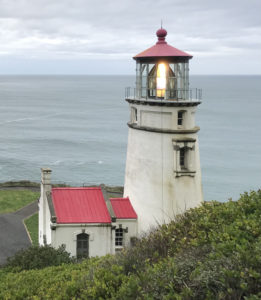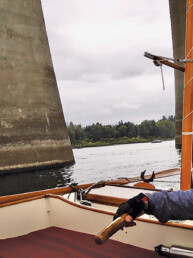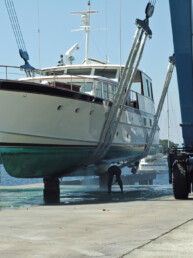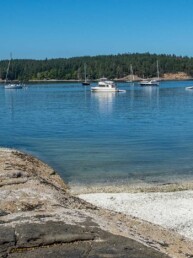If you see one lighthouse in Oregon, let it be the beacon at Heceta Head. For more than a century, mariners have relied on its light for safe passage along Oregon’s central coast. This is a seascape dotted with rocky islands and steep bluffs pounded by waves, making it especially scenic — and treacherous.
The striking white tower stands 56 feet tall, perched more than 200 feet above the Pacific Ocean on a headland named for Bruno de Heceta, a Spanish naval captain who explored the Oregon coastline in the 1770s. The promontory that became known as Heceta Head was part of the traditional lands of the Siuslaw Indians, who hunted and fished the abundant sea life there for thousands of years. During the 19th century, the US Lighthouse Service determined that this was the
perfect location for a lighthouse; and several shipwrecks in the vicinity, including the brig Fawn, the schooner Olivia Schultz, and the cargo ship Ocean King underscored the need for improved navigation.
The Heceta Head Lighthouse became part of a system of beacons along the Oregon coast designed to facilitate commercial shipping, ensuring further settlement and economic development. Still active, this light — Oregon’s most powerful — can be seen for more than 20 miles, flashing for eight seconds every minute.
The Light Station and Its Keepers

Construction began in the early 1890s. Work proceeded slowly, as the site’s secluded location made obtaining materials difficult. Stone and brick had to be shipped through perilous surf to the beach or carried by wagon from the town of Florence, 10 miles to the south. Once completed, the light station included a conical tower, two kerosene storage buildings, a house for the head keeper, and a house for two assistant keepers. It became operational in 1894, with the installation of the first-order Fresnel lens, manufactured in England by Chance Brothers Lighthouse Engineers.
While the beacon and its brilliant white light remained the purpose and the principal feature of the station, the keepers’ houses were noteworthy. Constructed of wood and painted white, they featured elaborate porches, ornamental trim, and a picket fence, suggesting that the rugged Oregon Coast could offer comfort and refined sensibilities during the late
19th century. Salaries for the keepers were modest ($800 annually for the head keeper, $600 for the first assistant, and $550 for the second assistant), and housing was considered part of the compensation.
Placement of the dwellings indicated a hierarchy among keepers. At Heceta Head, the assistants’ home was located farthest from the tower, while the head keeper enjoyed closer access. The home interiors also revealed rank — the chandelier in the head keeper’s residence included six bulbs, while fewer lights illuminated the assistant keepers’ quarters.
Andrew P.C. Hald served as the first head keeper of Heceta Head Lighthouse. Owing to the remoteness of the station, he had to walk down the beach from Newport for more than 20 miles to arrive at his new post in 1894. During his time at Heceta Head, Hald’s wife suffered from a serious illness and their baby daughter died, unable to reach medical attention. High turnover among the assistant keepers may have increased the sense of isolation, as several employees left the light station within the first two years.
Life at Heceta Head
![]() Duties were shared among the keepers. Rotating shifts allowed them a full night’s sleep every third day, with the first watch beginning at sunset and ending at midnight and the second extending into sunrise. Tasks included polishing the brass fittings, cleaning the lantern room glass, trimming wicks, filling the lamp reservoir, and keeping the lantern room interior free of soot and grease. The keepers’ wives were equally diligent, scrubbing windows and cupboards in anticipation of an unannounced visit by a lighthouse inspector, who checked not only the tower and machinery but also the interiors of the homes. Kids pitched in, too. “Dad and I shined all the brass fittings,” one son later recalled, making “things tidy and neat, like he was expecting the inspector any minute.” As the official instructions for Light-keepers of the United States explained, the keepers ”are required to be sober and industrious, and orderly in their families.” Such meticulous attention to detail reveals the gravity of the work of lightkeeping; the safety of vessels and the lives of mariners were at stake.
Duties were shared among the keepers. Rotating shifts allowed them a full night’s sleep every third day, with the first watch beginning at sunset and ending at midnight and the second extending into sunrise. Tasks included polishing the brass fittings, cleaning the lantern room glass, trimming wicks, filling the lamp reservoir, and keeping the lantern room interior free of soot and grease. The keepers’ wives were equally diligent, scrubbing windows and cupboards in anticipation of an unannounced visit by a lighthouse inspector, who checked not only the tower and machinery but also the interiors of the homes. Kids pitched in, too. “Dad and I shined all the brass fittings,” one son later recalled, making “things tidy and neat, like he was expecting the inspector any minute.” As the official instructions for Light-keepers of the United States explained, the keepers ”are required to be sober and industrious, and orderly in their families.” Such meticulous attention to detail reveals the gravity of the work of lightkeeping; the safety of vessels and the lives of mariners were at stake.
Living on the Oregon coast had its advantages. Children attending the one-room school on the property, for example, often ditched class to fish a nearby stream. According to one source, “at the sight of a salmon run, the entire class jumped up, grabbed spears kept near the door, and raced for the creek.” Several kids remembered dodging breakers during storms and frolicking in the waves. “The beach was my playground,” recalled one daughter of a teacher at the Heceta Head School. Over time, the light station became the site of weddings, picnics, dances, and other gatherings involving the growing community along the coast.
During the early 20th century, telephone lines connected the light station to the outside world. Initially, 16 parties shared the line, with eavesdropping becoming a favorite activity. In the 1930s, completion of the coastal road that would become US Highway 101 further linked Heceta Head to Florence and beyond.
The arrival of electricity marked the end of an era for the light station, and in the 1940s the head keeper’s house was removed. During World War II, the Coast Guard Beach Patrol deployed 75 men to Heceta Head, where they patrolled the shore and lived in the wooden barracks that had replaced the head keeper’s house. In the 1960s, the light was automated, and the assistant keeper’s house was turned over to the US Forest Service. In recognition of their historical significance, the Heceta Head light and keeper’s quarters were listed in the National Register of Historic Places in 1978. Lane Community College then leased this residence as a satellite campus for nearly 30 years.
The Haunting of Heceta House
Like many light stations in the Pacific Northwest, Heceta Head is reported to have a ghost. Why is paranormal activity so often associated with lighthouses? It may be that their isolated, often dangerous settings create a spooky atmosphere. It may be that the past echoes strongly in the beacons that played such a vital role in the region’s maritime development, triggering the imagination. In this instance, the ghost frequents the remaining residence rather than the tower.
Using a Ouija board, a group of Lane Community College students determined that the spirit, sometimes known as the “Grey Lady,” is called Rue. She may have been the wife of a keeper, and speculation suggests that she lost a child at the light station. Some sources claim that an abandoned grave was discovered on the property, and that the child may have been Head Keeper Hald’s daughter, who died by drowning. Stories of missing tools, flying objects, and glimpses of an old woman in the attic window continue, giving Heceta House the reputation of one of Oregon’s most haunted sites.
The Lighthouse Today
The light station was repaired and restored in 2011. Today, the beacon reminds us of the connection between mariners and the keepers on shore who ensured their safety. The house on the property is one of the coast’s last remaining lightkeeper’s residences, and now operates as a bed and breakfast through a concessionaire of the US Forest Service.
Modern day cruisers might catch a glimpse of Heceta Head if port-hopping down the Oregon Coast. If heading south from the safe waters and services at Newport to seek harbor in Florence, the Heceta Head will be about 18 nautical miles into that 24 nautical mile passage.
Learn more about visiting the Heceta Head Lighthouse at: www.hecetalighthouse.com.






